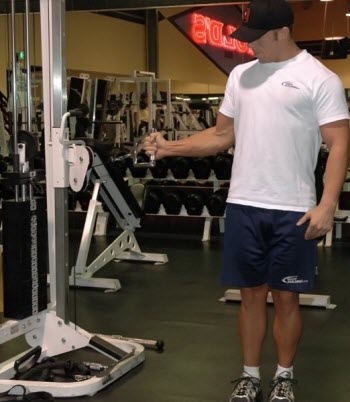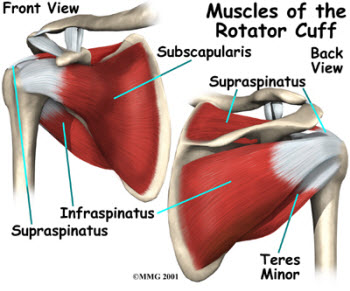 One of my best friends complained for over 4 years about his shoulder injury from a snowboarding mishap. Another friend ended up in surgery with a torn rotator cuff after falling on a railing doing some crazy trick. The latest story from another individual was a popped shoulder and yet another rotator cuff injury where the actual shoulder bone was sticking out! Don’t even ask me how many men over 35 I’ve talked to at the gym who’s #1 complaint is… MY SHOULDER HURTS! Guess what? It’s pretty common to have some type of shoulder injury as you get older and while it’s bothersome to plain out a life ruining experience, surgery isn’t always the answer and there’s things you can do to alleviate some of the pain. A rotator cuff injury can affect any age group. Younger people usually experience this pain beginning with some type of traumatic event or injury. Older people defined as “Over 40” start to feel some pain in shoulders with typical wear and tear. What is a Rotator Cuff? It’s the set of muscles that attach to the shoulder blade and tendons that ends on the shoulder, together know as the rotator cuff.
One of my best friends complained for over 4 years about his shoulder injury from a snowboarding mishap. Another friend ended up in surgery with a torn rotator cuff after falling on a railing doing some crazy trick. The latest story from another individual was a popped shoulder and yet another rotator cuff injury where the actual shoulder bone was sticking out! Don’t even ask me how many men over 35 I’ve talked to at the gym who’s #1 complaint is… MY SHOULDER HURTS! Guess what? It’s pretty common to have some type of shoulder injury as you get older and while it’s bothersome to plain out a life ruining experience, surgery isn’t always the answer and there’s things you can do to alleviate some of the pain. A rotator cuff injury can affect any age group. Younger people usually experience this pain beginning with some type of traumatic event or injury. Older people defined as “Over 40” start to feel some pain in shoulders with typical wear and tear. What is a Rotator Cuff? It’s the set of muscles that attach to the shoulder blade and tendons that ends on the shoulder, together know as the rotator cuff. 
It is estimated that more than 3 million people seek advice and care from a physician for rotator cuff problems.
What is a Rotator Cuff Tear in the Shoulder: Potential Signs and Symptoms
- pain when lifting the arm away from the body
- pain sometimes accompanied by weakness
- difficulty in sleeping on the injured side
- basic overhead repetitive activities cause pain
There’s a lot of talk about prevention of a rotator cuff injury. Maybe you should engage in rotator cuff strengthening exercises? However, the real truth is that most orthopedic surgeons agree that the research isn’t clear on whether strengthening the rotator cuff itself tends to prevent injury. The best tool is awareness. Advice for a Possible Rotator Cuff Injury:
- changing the technique and reducing the activity that aggravates the issues is important
- seek medical advice if the problem does not go away with rest and anti-inflammatory medication
Only 1 person out of the 3 stories I told you about in the beginning sought medical advice. That’s 33% of the individuals who had shoulder pain that was persistent actually asked for professional advice. The rest, let it heal, the pain persisted for months and over a year and never did fix itself. In fact, the tear probably got worse and while they could have used rotator cuff exercises at home, they did nothing but wait and the tear got too large to just let go. Seek medical advice! The sooner you get it diagnosed, the quicker you can get on the road to recovery. In reality, people with shoulder pain should get some type of medical evaluation by a specialist. The signs of a good examination will be one that evaluates not only the rotator cuff but the possibility of nearby bone spurs. The best diagnose comes from an X-Ray and an MRI. Did you know that a bone spur around the shoulder area can place a person at a higher risk for a tear? Not every rotator cuff injury means surgery. Even though tendons don’t repair themselves, it’s possible with physical therapy and cortisone injections to reduce the pain significantly. There’s even some rotator cuff exercises you can do at home to help with the pain. If the pain is significant and does not go away, rotator cuff surgery might be the only option. Treatment options have gone through a significant evolution over the last 5 to 7 years. A decade ago, any rotator cuff surgery usually meant an open incision. Today, many rotator cuff injuries can be done arthroscopically. This lesser invasive approach allows for a few tiny incisions to be made. As a result, this type of surgery gives the patient reduced healing time, rotator cuff rehabilitation is faster and pain control is better. In some cases where a bone spur is the problem, it’s possible to treat it with a laser technique. All of these rotator cuff surgery options can be performed on an out-patient basis. Many times with the patient awake. It’s a significant change from only a few years ago. The absolute best prevention of a rotator cuff injury is awareness. If you suspect something, changing your activities or the motion is one way to avoided the potential for a more serious shoulder problem. You can use some rotator cuff exercises to help strengthen the area and do some physcial therapy options at home to reduce the pain. If the pain doesn’t go away, seek medical advice. Many times, surgery can be avoided. If not, the sooner you get the area diagnosed by a specialist, the smaller the tear may be and less invasive prcedures can be used. This speeds up healing time, rehabilitation and allows for better pain control.
Thanks for the video, which should help prevent from rotor cuff injury.